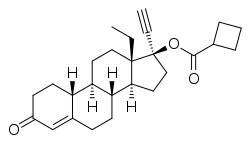Levonorgestrel cyclobutylcarboxylate
Levonorgestrel cyclobutylcarboxylate (or levonorgestrel 17β-cyclobutylcarboxylate; developmental code name HRP-001) is a progestin and a progestogen ester which was studied for potential use as an injectable hormonal contraceptive but was never marketed.[1][2][3][4][5][6][7][8][9][10] It was developed by the World Health Organization's Special Programme on Human Reproduction in the 1980s.[1][2][9] Analogues of levonorgestrel cyclobutylcarboxylate include levonorgestrel butanoate (HRP-002) and levonorgestrel cyclopropylcarboxylate (HRP-003).[1][2][3]
 | |
| Clinical data | |
|---|---|
| Other names | HRP-001; HRP001; Levonorgestrel cyclobutyl-carboxylate; Levonorgestrel cyclobutanecarboxylate; Levonorgestrel 17β-cyclobutylcarboxylate; 17α-Ethynyl-18-methyl-19-nortestosterone 17β-cyclobutylcarboxylate; 17α-Ethynyl-18-methylestr-4-en-17β-ol-3-one 17β-cyclobutylcarboxylate; 13-Ethyl-17α-hydroxy-18,19-dinorpregn-4-en-20-yn-3-one cyclobutanecarboxylate |
| Routes of administration | Intramuscular injection |
| Drug class | Progestogen; Progestin; Progestogen ester |
| Identifiers | |
IUPAC name
| |
| CAS Number | |
| PubChem CID | |
| ChemSpider | |
| ECHA InfoCard | 100.081.126 |
| Chemical and physical data | |
| Formula | C26H34O3 |
| Molar mass | 394.555 g/mol g·mol−1 |
| 3D model (JSmol) | |
SMILES
| |
InChI
| |
See also
References
- Benagiano, G., & Merialdi, M. (2011). Carl Djerassi and the World Health Organisation special programme of research in human reproduction. Journal für Reproduktionsmedizin und Endokrinologie-Journal of Reproductive Medicine and Endocrinology, 8(1), 10-13. http://www.kup.at/kup/pdf/10163.pdf
- Garza-Flores J, Hall PE, Perez-Palacios G (1991). "Long-acting hormonal contraceptives for women". J. Steroid Biochem. Mol. Biol. 40 (4–6): 697–704. doi:10.1016/0960-0760(91)90293-E. PMID 1958567.
- Wu L, Janagam DR, Mandrell TD, Johnson JR, Lowe TL (July 2015). "Long-acting injectable hormonal dosage forms for contraception". Pharm. Res. 32 (7): 2180–91. doi:10.1007/s11095-015-1686-2. PMID 25899076.
- Runnebaum, B.; Rabe, T.; Kiesel, L. (1988). "Trends in Hormonal Contraception": 109–121. doi:10.1007/978-3-642-73790-9_9. Cite journal requires
|journal=(help) - Marcus Filshie; John Guillebaud (22 October 2013). Contraception: Science and Practice. Elsevier Science. pp. 112–. ISBN 978-1-4831-6366-6.
- Elizabeth Connell (4 December 2001). The Contraception Sourcebook. McGraw Hill Professional. p. 133. ISBN 978-0-07-139945-6.
- Gerald I. Zatuchni; Northwestern University (Evanston, Ill.). Program for Applied Research on Fertility Regulation (1984). Long-Acting Contraceptive Delivery Systems: Proceedings of an International Workshop on Long-Acting Contraceptive Delivery Systems, May 31-June 3, 1983, New Orleans, Louisiana. Harper & Row Pub. p. 196. ISBN 978-0-06-142905-7.
- Egon Diczfalusy (1987). Fertility regulation today and tomorrow. Raven Press. p. 132. ISBN 978-0-88167-180-3.
- Seiichi Matsumoto; Japan Family Planning Association (1987). Recent advances in fertility control: proceedings of the 1st International Symposium on Recent Advances in Fertility Control, Tokyo, November 8, 1986. Excerpta Medica. p. 67. ISBN 978-90-219-1638-5.
- L. R. Sitruk-Ware; C. Wayne Bardin (1992). Contraception: newer pharmacological agents, devices, and delivery systems. M. Dekker. p. 62. ISBN 978-0-8247-8700-4.
This article is issued from
Wikipedia.
The text is licensed under Creative
Commons - Attribution - Sharealike.
Additional terms may apply for the media files.